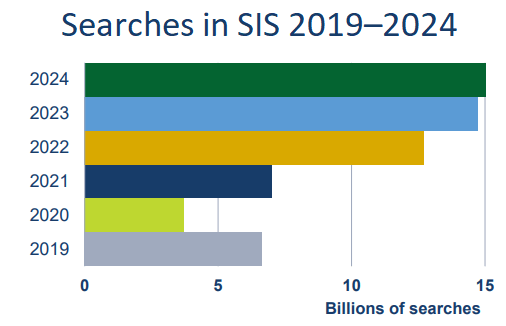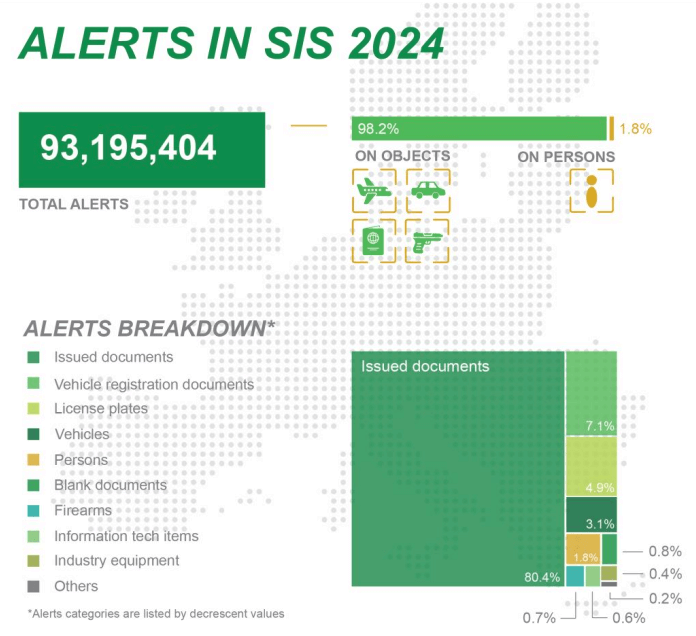Europe’s Schengen Information System (SIS) continued to expand in 2024, with more searches, more alerts, and more confirmed “hits” routed through national SIRENE Bureaux. The Netherlands generated the largest share of searches, followed by Belgium and France, according to eu-LISA’s new annual statistics.
In 2024, authorities connected to the Schengen Information System recorded 15,044,676,229 access instances. That figure includes 15,021,198,103 searches and 23,478,126 alert-management operations such as creating, updating, or deleting alerts. On average, over 41 million searches were performed every day and almost 1,100 hits were handled each day across Europe, the report shows.
Compared with 2023, alphanumeric searches edged up by about 2 percent, while automatically processed searches stayed broadly flat at 9.9 billion versus 10.1 billion a year earlier. The agency also reports a sharp rise in use of biometrics. AFIS queries reached 6,968,949 in 2024, a 66 percent increase.

As of December 31, 2024, the database stored 93,195,404 alerts. These cover persons and a wide range of objects, from vehicles and firearms to identity documents and containers. For readers seeking longer-term perspective, earlier data showed the system being used over seven billion times in 2021a baseline that underlines how quickly usage has grown since then.


More Hits, More Follow-up
SIRENE Bureaux, which coordinate supplementary information exchanges on SIS alerts, reported 397,804 hits on foreign alerts in 2024. That is an 11 percent increase over 2023 and reflects the system’s greater operational reach. eu-LISA notes that these hits trigger coordination between the country that entered an alert and the country that detected it.
Usage of SIS has continued to increase, demonstrating the central role the system plays in police cooperation, external border management, judicial cooperation, and migration management.
Return Decisions: Alerts and Confirmed Outcomes
By year-end, Member States had stored 570,947 alerts on third-country nationals subject to a return decision. In 2024, these alerts generated 103,901 hits on foreign alerts. There were 18,904 confirmed returns linked to hits abroad on own alerts, including 948 cases where the person was subject to removal. Authorities also logged 9,987 information exchanges related to hits at external borders upon entry.
Who Searched Most
As in recent years, the Netherlands conducted the largest share of SIS searches performed by Member States, accounting for 28 percent. Belgium followed with 20 percent, then France with 9 percent. Eurojust did not report any searches in 2024. Frontex began searching SIS in Italy from June 2024 and in Cyprus from December, while Europol also performed searches directly in the central system.
Context: Upgrades and Interoperability
The report reiterates that comparisons with earlier years must consider the reinforced SIS that took effect in March 2023. Features added under the new legal framework, together with the EU’s broader interoperability program for borders and police cooperation, are shaping how national systems query and manage alerts.
For broader context on the border IT rollout and what it means for travellers, see our explainer on what to expect when the Entry-Exit System begins on October 12and our update on the €20 ETIAS fee and the EU’s 2026 launch timeline.
